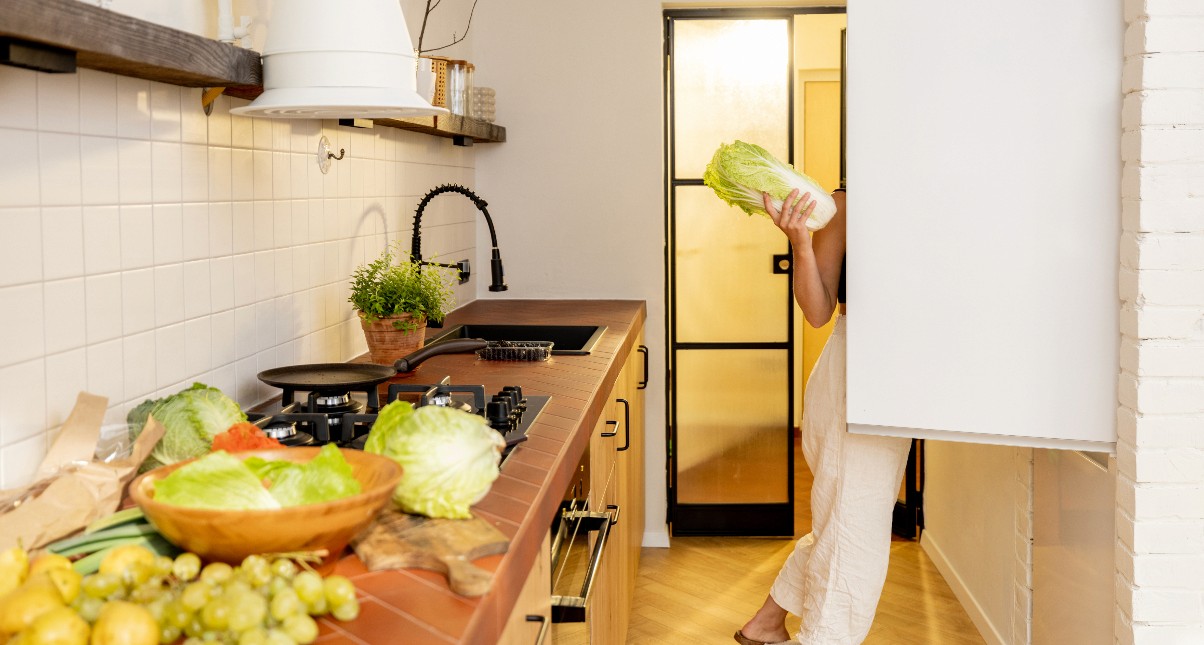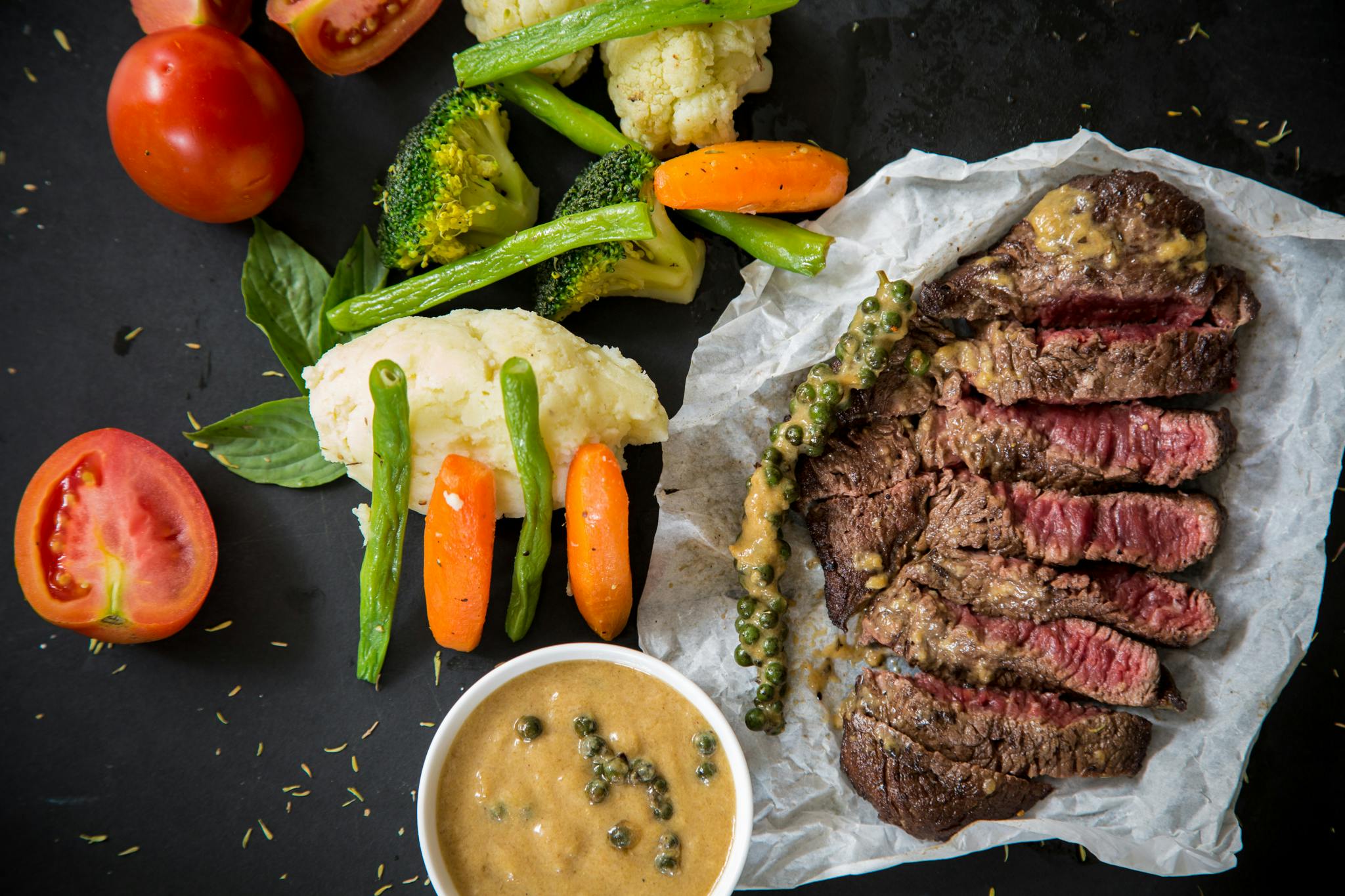Your freezer is one of the most valuable tools in the kitchen. It allows you to prolong the life of seasonal produce, stock up on bulk ingredients and prepared food, and safely press pause on what might otherwise be thrown out. Without the proper attention however, freezers can easily grow out of control - becoming more of a black hole instead of a powerful kitchen time machine.
Thankfully, a little planning goes a long way, and below are some easy ways you can keep your freezer organized. Your future self will thank you.
Know what not to freeze
Avoid freezing produce with high water-content, such as lettuce, melons, citrus, and cucumbers, as well as delicate dairy products like yogurt, cream or cottage cheese, sour cream, and cream-based soups. Cooked pasta, fried food, and whole or cooked eggs also don’t freeze well.
Practice good maintenance
To best preserve food's flavor, texture, color, and nutritional content, make sure your freezer is set to 0°F. Aim to clean it out every six months. Over time, ice crystal damage can affect the quality and taste of frozen food, so use this time to toss foods that are freezer-burnt, past their prime, or unidentifiable. Take an inventory of your freezer contents to minimize it becoming overpacked - circulation is key to keep it functioning well.
Use the right packaging
How food is packaged depends on freezer space, how the food will be reheated later, and what you intend to do with the food. Use plastic wrap to package individual items like filets of meat, chicken, or fish. For smaller items such as berries, peas, or nuts, lay them out in a single layer before transferring them to a freezer-safe bag. Opt for plastic or glass containers with lids for liquids, and be sure to keep some room at the top for expansion.
Divide and label
Instead of simply putting entire packs of meat into the freezer, take the time to individually wrap usable portions. This way, you can thaw exactly what you need instead of having to deal with a frozen mass. For easy identification, label all your food items with the name, date, and year - all you need is a little masking tape and permanent marker.
Organize your storage
Keep items that you reach for the most in the most accessible place. Store meat and fish on bottom shelves, as this will prevent contamination if there’s a leak. Use the other side of the shelf for liquids, frozen meals, and leftovers. All other frozen foods, like fruits and vegetables, baked goods, and ice trays can be stored on the top-most shelf. And remember: the door is the warmest part of the freezer, so avoid storing items there that can be easily ruined by melting and refreezing, like ice cream. Instead, use this part of the freezer for nuts, flour, bread, butter, and ice packs.
Your freezer is one of the most valuable tools in the kitchen. It allows you to prolong the life of seasonal produce, stock up on bulk ingredients and prepared food, and safely press pause on what might otherwise be thrown out. Without the proper attention however, freezers can easily grow out of control - becoming more of a black hole instead of a powerful kitchen time machine.
Thankfully, a little planning goes a long way, and below are some easy ways you can keep your freezer organized. Your future self will thank you.
Know what not to freeze
Avoid freezing produce with high water-content, such as lettuce, melons, citrus, and cucumbers, as well as delicate dairy products like yogurt, cream or cottage cheese, sour cream, and cream-based soups. Cooked pasta, fried food, and whole or cooked eggs also don’t freeze well.
Practice good maintenance
To best preserve food's flavor, texture, color, and nutritional content, make sure your freezer is set to 0°F. Aim to clean it out every six months. Over time, ice crystal damage can affect the quality and taste of frozen food, so use this time to toss foods that are freezer-burnt, past their prime, or unidentifiable. Take an inventory of your freezer contents to minimize it becoming overpacked - circulation is key to keep it functioning well.
Use the right packaging
How food is packaged depends on freezer space, how the food will be reheated later, and what you intend to do with the food. Use plastic wrap to package individual items like filets of meat, chicken, or fish. For smaller items such as berries, peas, or nuts, lay them out in a single layer before transferring them to a freezer-safe bag. Opt for plastic or glass containers with lids for liquids, and be sure to keep some room at the top for expansion.
Divide and label
Instead of simply putting entire packs of meat into the freezer, take the time to individually wrap usable portions. This way, you can thaw exactly what you need instead of having to deal with a frozen mass. For easy identification, label all your food items with the name, date, and year - all you need is a little masking tape and permanent marker.
Organize your storage
Keep items that you reach for the most in the most accessible place. Store meat and fish on bottom shelves, as this will prevent contamination if there’s a leak. Use the other side of the shelf for liquids, frozen meals, and leftovers. All other frozen foods, like fruits and vegetables, baked goods, and ice trays can be stored on the top-most shelf. And remember: the door is the warmest part of the freezer, so avoid storing items there that can be easily ruined by melting and refreezing, like ice cream. Instead, use this part of the freezer for nuts, flour, bread, butter, and ice packs.
Your freezer is one of the most valuable tools in the kitchen. It allows you to prolong the life of seasonal produce, stock up on bulk ingredients and prepared food, and safely press pause on what might otherwise be thrown out. Without the proper attention however, freezers can easily grow out of control - becoming more of a black hole instead of a powerful kitchen time machine.
Thankfully, a little planning goes a long way, and below are some easy ways you can keep your freezer organized. Your future self will thank you.
Know what not to freeze
Avoid freezing produce with high water-content, such as lettuce, melons, citrus, and cucumbers, as well as delicate dairy products like yogurt, cream or cottage cheese, sour cream, and cream-based soups. Cooked pasta, fried food, and whole or cooked eggs also don’t freeze well.
Practice good maintenance
To best preserve food's flavor, texture, color, and nutritional content, make sure your freezer is set to 0°F. Aim to clean it out every six months. Over time, ice crystal damage can affect the quality and taste of frozen food, so use this time to toss foods that are freezer-burnt, past their prime, or unidentifiable. Take an inventory of your freezer contents to minimize it becoming overpacked - circulation is key to keep it functioning well.
Use the right packaging
How food is packaged depends on freezer space, how the food will be reheated later, and what you intend to do with the food. Use plastic wrap to package individual items like filets of meat, chicken, or fish. For smaller items such as berries, peas, or nuts, lay them out in a single layer before transferring them to a freezer-safe bag. Opt for plastic or glass containers with lids for liquids, and be sure to keep some room at the top for expansion.
Divide and label
Instead of simply putting entire packs of meat into the freezer, take the time to individually wrap usable portions. This way, you can thaw exactly what you need instead of having to deal with a frozen mass. For easy identification, label all your food items with the name, date, and year - all you need is a little masking tape and permanent marker.
Organize your storage
Keep items that you reach for the most in the most accessible place. Store meat and fish on bottom shelves, as this will prevent contamination if there’s a leak. Use the other side of the shelf for liquids, frozen meals, and leftovers. All other frozen foods, like fruits and vegetables, baked goods, and ice trays can be stored on the top-most shelf. And remember: the door is the warmest part of the freezer, so avoid storing items there that can be easily ruined by melting and refreezing, like ice cream. Instead, use this part of the freezer for nuts, flour, bread, butter, and ice packs.
Your freezer is one of the most valuable tools in the kitchen. It allows you to prolong the life of seasonal produce, stock up on bulk ingredients and prepared food, and safely press pause on what might otherwise be thrown out. Without the proper attention however, freezers can easily grow out of control - becoming more of a black hole instead of a powerful kitchen time machine.
Thankfully, a little planning goes a long way, and below are some easy ways you can keep your freezer organized. Your future self will thank you.
Know what not to freeze
Avoid freezing produce with high water-content, such as lettuce, melons, citrus, and cucumbers, as well as delicate dairy products like yogurt, cream or cottage cheese, sour cream, and cream-based soups. Cooked pasta, fried food, and whole or cooked eggs also don’t freeze well.
Practice good maintenance
To best preserve food's flavor, texture, color, and nutritional content, make sure your freezer is set to 0°F. Aim to clean it out every six months. Over time, ice crystal damage can affect the quality and taste of frozen food, so use this time to toss foods that are freezer-burnt, past their prime, or unidentifiable. Take an inventory of your freezer contents to minimize it becoming overpacked - circulation is key to keep it functioning well.
Use the right packaging
How food is packaged depends on freezer space, how the food will be reheated later, and what you intend to do with the food. Use plastic wrap to package individual items like filets of meat, chicken, or fish. For smaller items such as berries, peas, or nuts, lay them out in a single layer before transferring them to a freezer-safe bag. Opt for plastic or glass containers with lids for liquids, and be sure to keep some room at the top for expansion.
Divide and label
Instead of simply putting entire packs of meat into the freezer, take the time to individually wrap usable portions. This way, you can thaw exactly what you need instead of having to deal with a frozen mass. For easy identification, label all your food items with the name, date, and year - all you need is a little masking tape and permanent marker.
Organize your storage
Keep items that you reach for the most in the most accessible place. Store meat and fish on bottom shelves, as this will prevent contamination if there’s a leak. Use the other side of the shelf for liquids, frozen meals, and leftovers. All other frozen foods, like fruits and vegetables, baked goods, and ice trays can be stored on the top-most shelf. And remember: the door is the warmest part of the freezer, so avoid storing items there that can be easily ruined by melting and refreezing, like ice cream. Instead, use this part of the freezer for nuts, flour, bread, butter, and ice packs.
Your freezer is one of the most valuable tools in the kitchen. It allows you to prolong the life of seasonal produce, stock up on bulk ingredients and prepared food, and safely press pause on what might otherwise be thrown out. Without the proper attention however, freezers can easily grow out of control - becoming more of a black hole instead of a powerful kitchen time machine.
Thankfully, a little planning goes a long way, and below are some easy ways you can keep your freezer organized. Your future self will thank you.
Know what not to freeze
Avoid freezing produce with high water-content, such as lettuce, melons, citrus, and cucumbers, as well as delicate dairy products like yogurt, cream or cottage cheese, sour cream, and cream-based soups. Cooked pasta, fried food, and whole or cooked eggs also don’t freeze well.
Practice good maintenance
To best preserve food's flavor, texture, color, and nutritional content, make sure your freezer is set to 0°F. Aim to clean it out every six months. Over time, ice crystal damage can affect the quality and taste of frozen food, so use this time to toss foods that are freezer-burnt, past their prime, or unidentifiable. Take an inventory of your freezer contents to minimize it becoming overpacked - circulation is key to keep it functioning well.
Use the right packaging
How food is packaged depends on freezer space, how the food will be reheated later, and what you intend to do with the food. Use plastic wrap to package individual items like filets of meat, chicken, or fish. For smaller items such as berries, peas, or nuts, lay them out in a single layer before transferring them to a freezer-safe bag. Opt for plastic or glass containers with lids for liquids, and be sure to keep some room at the top for expansion.
Divide and label
Instead of simply putting entire packs of meat into the freezer, take the time to individually wrap usable portions. This way, you can thaw exactly what you need instead of having to deal with a frozen mass. For easy identification, label all your food items with the name, date, and year - all you need is a little masking tape and permanent marker.
Organize your storage
Keep items that you reach for the most in the most accessible place. Store meat and fish on bottom shelves, as this will prevent contamination if there’s a leak. Use the other side of the shelf for liquids, frozen meals, and leftovers. All other frozen foods, like fruits and vegetables, baked goods, and ice trays can be stored on the top-most shelf. And remember: the door is the warmest part of the freezer, so avoid storing items there that can be easily ruined by melting and refreezing, like ice cream. Instead, use this part of the freezer for nuts, flour, bread, butter, and ice packs.





